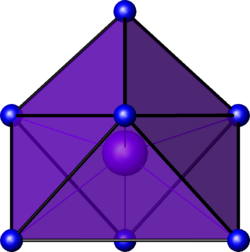Physics:Capped octahedral molecular geometry
From HandWiki
| Capped octahedral molecular geometry | |
|---|---|
 | |
| Examples | MoF−7 |
| Point group | C3v |
| Coordination number | 7 |
In chemistry, the capped octahedral molecular geometry describes the shape of compounds where seven atoms or groups of atoms or ligands are arranged around a central atom defining the vertices of a gyroelongated triangular pyramid. This shape has C3v symmetry and is one of the three common shapes for heptacoordinate transition metal complexes, along with the pentagonal bipyramid and the capped trigonal prism.[1][2]
Examples of the capped octahedral molecular geometry are the heptafluoromolybdate (MoF−7) and the heptafluorotungstate (WF−7) ions.[3][4]
The "distorted octahedral geometry" exhibited by some AX6E1 molecules such as xenon hexafluoride (XeF6) is a variant of this geometry, with the lone pair occupying the "cap" position.
References
- ↑ Roald. Hoffmann; Barbara F. Beier; Earl L. Muetterties; Angelo R. Rossi (1977). "Seven-coordination. A molecular orbital exploration of structure, stereochemistry, and reaction dynamics". Inorganic Chemistry 16 (3): 511–522. doi:10.1021/ic50169a002.
- ↑ Wells A.F. (1984) Structural Inorganic Chemistry 5th edition Oxford Science Publications Script error: No such module "CS1 identifiers".
- ↑ Kaupp, Martin (2001). ""Non-VSEPR" Structures and Bonding in d(0) Systems". Angew Chem Int Ed Engl 40 (1): 3534–3565. doi:10.1002/1521-3773(20011001)40:19<3534::AID-ANIE3534>3.0.CO;2-#. PMID 11592184.
- ↑ Zhenyang Lin; Ian Bytheway (1996). "Stereochemistry of Seven-Coordinate Main Group and d0 Transition Metal Molecules". Inorganic Chemistry 35 (3): 594–603. doi:10.1021/ic950271o.
 |
